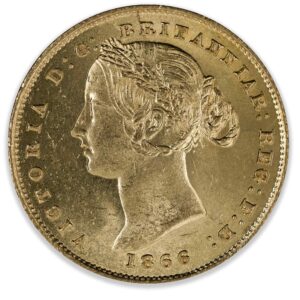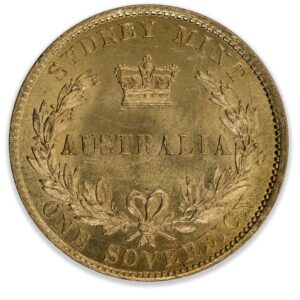At Jaggards, we’re proud to offer you the opportunity to own a piece of Australia’s golden heritage. Sydney Mint Sovereigns represent one of the most historically significant and distinctive gold coins in both Australian and British numismatic history. Produced from 1855 to 1870 with a unique Australian design, these sovereigns hold the distinction of being the first official gold coinage produced in Australia and the first sovereigns minted outside of London. Their distinctive appearance, historical importance, and increasing scarcity have made them highly prized by collectors and investors worldwide.
What makes Sydney Mint Sovereigns truly exceptional is their unique design – a deliberate departure from the standard imperial sovereign design that represented the only major design exception in sovereign history. This special design came about because officials worried that if the Sydney Mint’s coins failed to meet standards, they could be easily identified and removed from circulation.
Type I Design (1855-1856)
The first Sydney Mint Sovereign design featured:
- Obverse: A filleted bust of Queen Victoria designed by James Wyon, slightly different from portraits used on British sovereigns
- Reverse: Displayed “AUSTRALIA” and “SYDNEY MINT” prominently, based loosely on contemporary British sixpence and shilling designs
- Legend: “SYDNEY MINT” and “AUSTRALIA” appear on the reverse, making these the only sovereigns ever to bear the name of their country
- Edge: Standard milled (reeded) edge like other sovereigns
Type II Design (1857-1870)
In 1857, the design was modified:
- Obverse: New portrait by Leonard Charles Wyon with a distinctly Australian element—a sprig of banksia in Queen Victoria’s hair
- Reverse: Maintained the “AUSTRALIA” and “SYDNEY MINT” inscriptions but with slight design modifications
- Legend: Maintained the unique territorial designation setting it apart from all other sovereigns
Imperial Design Period (1871-1926)
Following an Imperial Proclamation in 1866, the Sydney Mint transitioned to standard imperial designs in 1871:
- Imperial Design with “S” Mint Mark (1871-1926): These later coins abandoned the distinctive Australian design in favor of the standard British sovereign designs:
- Shield reverse (1871-1887): With Queen Victoria’s Young Head portrait
- St. George and dragon reverse (1871-1926): Initially with Queen Victoria’s Young Head, then later with her Jubilee Head (1887-1893) and Old Head (1893-1901) portraits, followed by Edward VII (1902-1910) and George V (1911-1926) portraits
While coins from the 1871-1926 period are technically “Sydney Mint sovereigns” because they were produced at the Sydney Mint, collectors often specifically prize the 1855-1870 issues with their distinctive Australian design as the “true” Sydney Mint sovereigns due to their unique appearance and historical significance.
The Sydney Mint closed in 1926, ending over 70 years of sovereign production in Australia’s first mint.
FAQs
The Sydney Mint was established in direct response to the Australian gold rushes that began in 1851. With the sudden influx of gold, particularly from the finds near Bathurst in New South Wales and later Victoria, there was an urgent need to convert raw gold into official coinage. Prior to the mint’s establishment, gold dust and privately-issued tokens were being used as unofficial currency, creating concerns about purity and weight standards.
Yes, the Sydney Mint was established as the first branch of the Royal Mint outside of London. Twenty staff members were sent from London to Australia to help set up the new mint in the Old Rum Hospital building on Macquarie Street. It operated under Royal Mint supervision but with certain independence in design during its early years.
The Sydney Mint operated from 1855 to 1926. However, the distinctive Sydney Mint Sovereign designs were only produced from 1855 to 1870. After 1871, the mint adopted the standard imperial sovereign design with the “S” mint mark to indicate Sydney production.
Sydney Mint Sovereigns featured a unique design that was distinctly Australian – the only significant design exception ever granted in sovereign history. Unlike all other sovereigns, they prominently displayed the words “AUSTRALIA” and “SYDNEY MINT” on the reverse. Additionally, the Type II design (1857-1870) featured a portrait of Queen Victoria with a sprig of Australian banksia in her hair.
Sydney Mint Sovereigns have the same specifications as all other sovereigns:
- Weight: 7.98 grams
- Diameter: 22.05 mm
- Gold Content: 22 carat (91.67% pure gold)
- Pure Gold Weight: 7.32 grams (0.2354 troy ounces)
- Edge: Milled (reeded)
Uncirculated Sydney Mint Sovereigns have not been used in commerce, preserving their original brilliance and detail. “Very Fine” coins have seen some circulation, showing light to moderate wear while retaining key design elements.
A total of 116,704.050 Sydney Mint Sovereigns were minted.
The 1920 Sydney Mint Sovereign has a unique story. Approximately 360,000 coins were minted in January 1920 but dated 1919, as there were no plans to produce more sovereigns that year. However, the prominent New South Wales politician and trade unionist Jacob Garrard ordered an additional group of sovereigns as gifts to celebrate his golden wedding anniversary on April 15, 1920. Little did he know that this decision would create the most important rarity in the Australian sovereign series. The four coins that have since surfaced can all be traced to Garrard’s immediate family. In 2012, Robert Jaggard (founder), made a record-breaking bid at auction for the 1920 Sydney Mint Sovereign. Robert Jaggard has been extremely lucky to be part of the sales of 3 Sydney Mint sovereigns.

